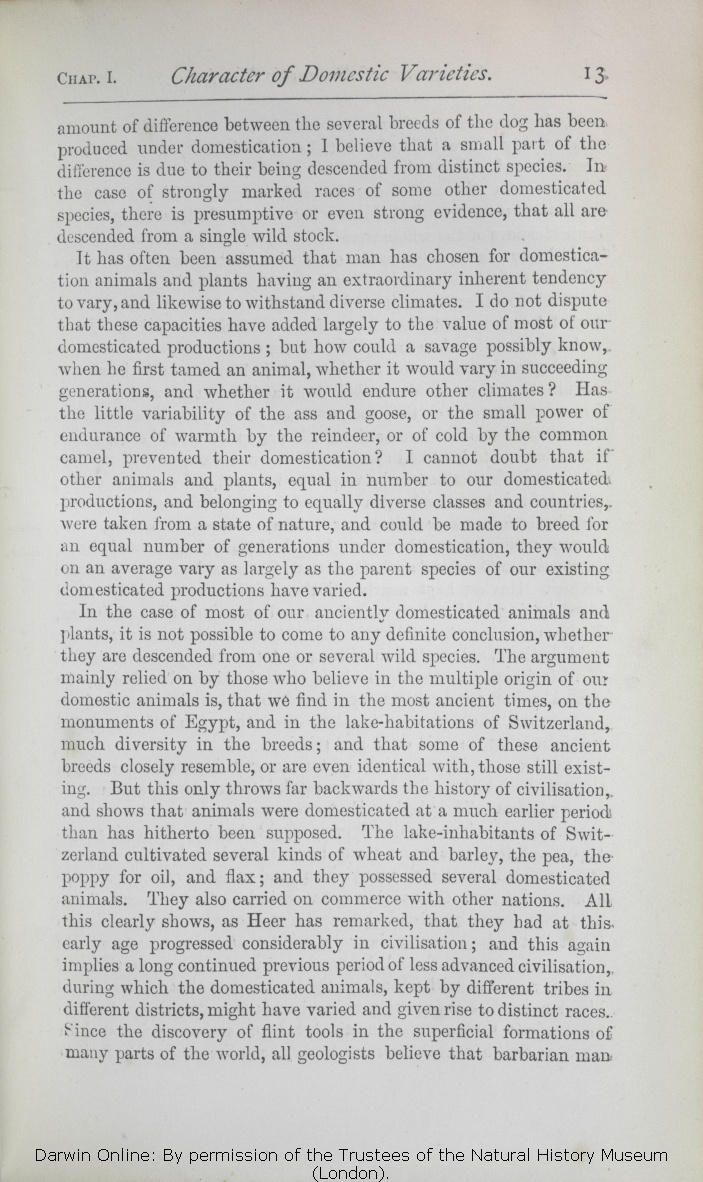descended from
distinct species. | distinct species. 1872 |
| any one wild species; but, in the case of some other domestic races, there is presumptive, or even strong, evidence in favour of this view. 1859 |
| 1 blocks not present in 1859 1872; present in 1860 1861 1866 1869 | | the whole amount of difference between the several breeds of the dog has been produced under domestication; I believe that some small part of the difference is due to their having
descended from distinct species.
|
| strongly marked races of some 1872 |
| some 1860 1861 1866 |
| strongly marked races in some 1869 |
| presumptive 1872 | | presumptive, 1860 1861 1866 1869 |
| are 1869 1872 |
| the breeds have 1860 1861 1866 |
|
|
It has often been assumed that man has chosen for domestication animals and plants having an extraordinary inherent tendency to vary, and likewise to withstand diverse climates. I do not dispute that these capacities have added largely to the value of most of our domesticated productions; but how could a savage possibly know, when he first tamed an animal, whether it would vary in succeeding generations, and whether it would endure other climates? Has the little variability of the ass
and goose, | and goose, 1866 1869 1872 | | or guinea-fowl, 1859 1860 1861 |
| reindeer, 1860 1861 1866 1869 1872 | | rein-deer, 1859 |
| camel, 1859 1860 1866 1869 1872 | | camel 1861 |
| on an average vary 1866 1869 1872 |
| vary on an average 1859 1860 1861 |
|
|
In the case of most of our anciently domesticated animals and plants,
...| OMIT 1861 1866 1869 1872 |
| I do not think 1859 1860 |
| not possible 1861 1866 1869 1872 | | possible 1859 1860 |
| are 1869 1872 | | have 1859 1860 1861 1866 |
| wild species. 1860 1861 1866 1869 1872 | | species. 1859 |
| times, 1866 1869 1872 |
| records, more especially 1859 1860 1861 |
| and 1866 1869 1872 | | much diversity 1859 1860 1861 |
| lake-habitations of Switzerland, much diversity in 1866 1869 1872 |
| breeds; and that some of 1859 1860 1861 |
| breeds; 1866 1869 1872 | | breeds 1859 1860 1861 |
| and that some of these ancient breeds closely resemble, or are even 1872 |
| closely resemble, perhaps are 1859 1860 1861 |
| and that some of these ancient breeds closely resemble or are even 1866 1869 |
| with, 1859 1860 1861 1872 | | with 1866 1869 |
| civilisation, 1872 | | civilization, 1866 1869 |
| animals. 1872 | | animals; 1866 1869 |
| carried on commerce 1872 |
| commerce 1866 1869 |
| civilisation; 1872 | | civilization; 1866 1869 |
| long continued 1872 | | long-continued 1866 1869 |
| civilisation, 1872 | | civilization, 1866 1869 |
|









